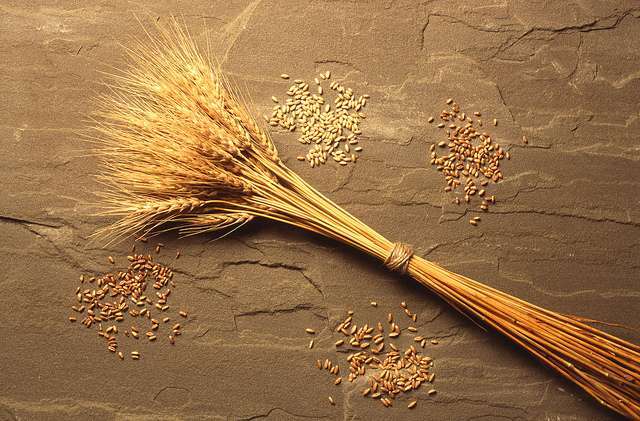Yields are low, but protein content high for spring wheat grown in state
COLBY, Kan. – Ongoing research trials on growing spring wheat in Kansas continue to indicate that producers can expect reduced yields compared to the more popularly grown hard red winter varieties in the state.
But Lucas Haag, a crop production specialist at the Northwest Research-Extension Center in Colby, said that spring wheat might fit as a niche in certain crop rotations and markets. Spring wheat, he added, may provide producers an opportunity to grow a crop that is high in protein content and a favored product for baker’s flour.
“Really what’s driving (interest in spring wheat) is producers are looking for another alternative to fallow,” Haag said, referring to farmland that is left unsown for a period of time. “Over the past couple years we have seen a lot of acres where producers have attempted to go in and seed winter wheat back into fresh corn stalks or freshly harvested sorghum stalks, with varying levels of success.”
Winter wheat indicates those varieties planted in the autumn or winter for harvest the following summer. Spring wheat, on the other hand, is usually planted in the spring and harvest approximately a week to 10 days after the winter wheat harvest.
Haag said planting winter wheat into fresh row crop stalks has mixed success because the ground is usually dry and planting dates are later than optimal. When winter wheat is planted into fresh stalks, yields are typically lower, he added.
“There has been interest into whether we can accomplish the same thing but do it with spring wheat,” Haag said. “The thought is that we could frost-seed that wheat – in December, January or February if the ground allows it – or even on-time seeding in February or March.”
Researchers at the Colby agricultural experiment field have been testing the possibility of growing spring wheat in Kansas for more than 100 years. Haag said there is data from trials held between 1915-1950; additional studies were done in the 1970s and again the early 2000s.
All of those studies show a similar trend: “Spring wheat grown on fallow makes just a tick under half of what winter wheat grown on fallow would make in the same year.”
For yield potential, Kansas spring wheat has not been favored compared to areas such as North Dakota, which annually challenges Kansas as the top wheat producer in the United States. Spring wheat is limited in Kansas because annual temperatures are typically higher March through May, an important time for flowering and grain fill.
Spring wheat trials at Colby in 2019 yielded as much as 50 pounds per bushel when grown on fallow, but yields dropped to 20 pounds per bushel in 2020 due to severe heat, “and the rotation effect from planting the wheat into fresh corn stalks,” according to Haag.
The 2020 trials, however, also yielded wheat with protein content at 16-18%, “which is quite high, and higher than it would need to be for the quality standards of wheat,” Haag said. Those fields, however, were “over-fertilized (based on that year’s yield potential),” according to Haag, so there is still work to do to balance inputs.
Even so, Haag said high protein spring wheat creates an opportunity for farmers who can effectively plan to capitalize on the market.
“Typically, our Kansas flour mills import some spring wheat from the northern plains to improve the quality profile of the flour they’re making out of predominantly hard red winter wheat,” Haag said. “If we could raise quality spring wheat here, we have an obvious freight advantage over the wheat they’re bringing in from the Plains.”
Haag said local elevators have expressed an interest in storing spring wheat in Kansas. And some producers are improving their on-farm storage capabilities for spring wheat.
“It’s important that producers have some marketing options, or plans lined up ahead of time,” Haag said.
The results of K-State’s spring wheat trials are available online from the Northwest Research-Extension Center. More information is also available from your local K-State Research and Extension agent.
A full interview with Haag is available online on the weekday radio program, Agriculture Today.
FOR PRINT PUBLICATIONS: Links used in this story
Northwest Research-Extension Center, https://www.northwest.k-state.edu
K-State Research and Extension local offices, https://www.ksre.k-state.edu/about/stateandareamaps.html
Agriculture Today, https://www.ksre.k-state.edu/news/radio-network/ag-today.html
K State Research and Extension is a short name for the Kansas State University Agricultural Experiment Station and Cooperative Extension Service, a program designed to generate and distribute useful knowledge for the well being of Kansans. Supported by county, state, federal and private funds, the program has county extension offices, experiment fields, area extension offices and regional research centers statewide. Its headquarters is on the K State campus in Manhattan. For more information, visit www.ksre.ksu.edu. K-State Research and Extension is an equal opportunity provider and employer.
Story by:
Pat Melgares
785-532-1160
[email protected]
For more information:
Lucas Haag
785-462-6281
[email protected]





